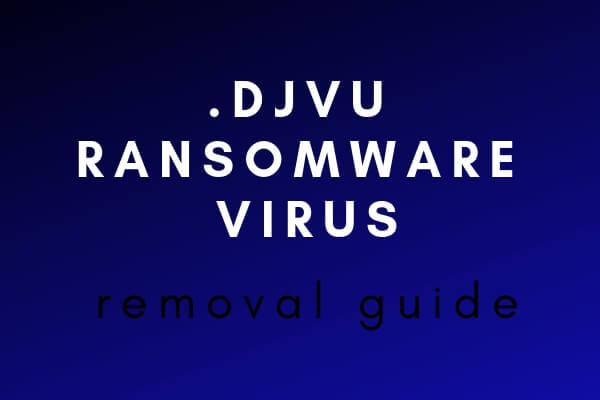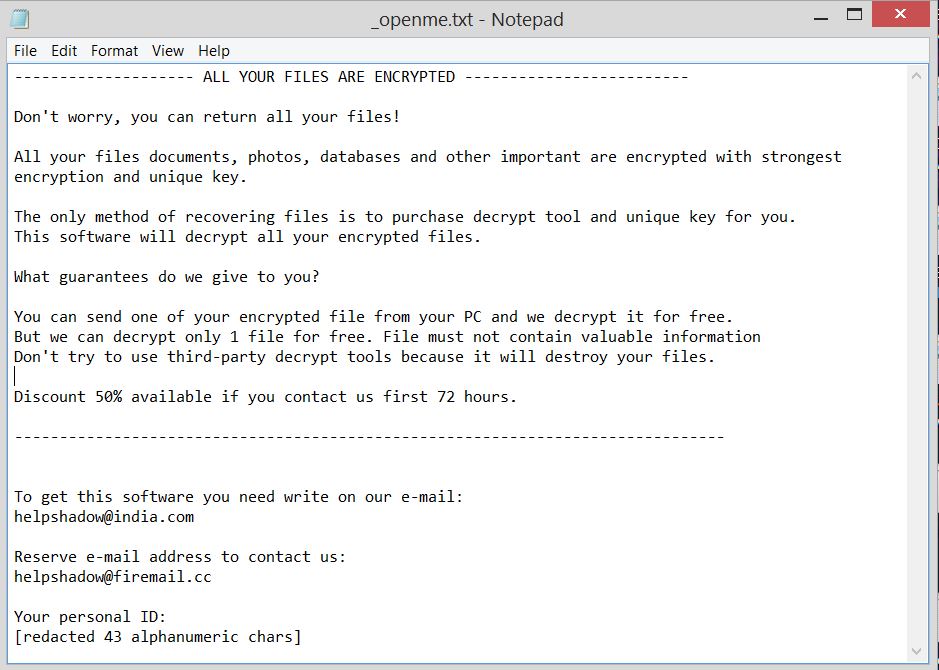
An infection with the dangerous .djvu ransomware virus leads to serious security issues. With our removal guide, victims can try to secure their computers and restore encrypted files.
Manual Removal Guide
Files Recovery Approaches
Skip all steps and download anti-malware tool that will safely scan and clean all harmful files it detects on your PC.
SpyHunter is a Windows application designed to scan for, identify, remove and block malware, potentially unwanted programs (PUPs) and other objects. By purchasing the full version, you will be able to remove detected malware instantly. Additional information about SpyHunter / Help to uninstall SpyHunter
Distribution of .djvu Ransomware Virus
.djvu crypto virus is a devastating data locker ransomware that has been recently released in attack campaigns against computer users worldwide. Threat actors could be utilizing widely used tactics of distribution to infect computer systems.
One of the methods that may be used by the malicious actors behind .djvu crypto virus include the coordination of SPAM email messages — they are used to spread the threat by sending out messages that pose as legitimate notifications sent by popular Internet portals or services that the targets may use. The virus files can be either directly attached or linked in the body. They can also be uploaded to fake download sites which are designed to appear like any of the popular Internet portals or vendor download sites. The malicious actors may use similar sounding domain names, certificates and hijacked design and contents to coerce the victims into thinking that they are accessing the legitimate address.
Another way that the threat may spread is through infected payloads — the use of various files that are infected with virus code. A popular example is the malicious document which can take any form: presentations, rich text files, spreadsheets and databases. Once they are opened by the victims a notification message will pop-up asking the target users to enable the built-in scripts. If this is done the virus infection will follow. The other popular technique is the inclusion of the code in application installers. They are malicious copies of legitimate setup files of popular end-user programs that have been modified with the .djvu ransomware code.
Ransomware files are also popularly spread by fake user profiles — they can post to community forums or social media accounts. The criminals can utilize both fake or stolen identities to increase the number of infected users.
In certain cases, the criminals may also be distributed via malicious browser plugins — additions to the most popular web browsers that are advertised as useful. The plugins are uploaded to the official repositories and often make use of fake or hijacked user reviews and developer credentials. Once they are installed by the users they will execute their built-in instructions that in many cases leads to the .djvu ransomware virus infection in the end.
Impact of .djvu Ransomware Virus
The .djvu ransomware virus is a threat that infiltrates computer systems with the purpose to encrypt certain types of files. This devastating impact is misused by hackers that extort a ransom payment from infected users.
When first executed on a target system, .djvu ransomware virus scans the system for particular security mechanisms in an attempt to evade detection and continue with its malicious activities. Following this phase, it establishes more malware files on the system. This is possible either by their direct creation on the system or by their download from a remote server.
With the help of these files, .djvu crypto virus becomes able to complete all infection stages which eventually enables hackers to extort a ransom fee for the decryption of corrupted files. While infecting the system this ransomware could access some of the essential system components like the Registry Editor. By doing this it aims two things – persistent presence on the infected system and launch of its ransom message.
In order to achieve these two things, .djvu needs to add malicious values under specific registry sub-keys – Run and RunOnce. Both keys manage the automatic execution of all files and processes listed under them. So once plagued the registry sub-key Run triggers ransomware files on each system start while RunOnce cause the appearance of a file called _openme.txt.
This text file is dropped by .djvu crypto virus soon after all target files are encrypted. As of target files, they all may be of commonly used types so that you can lose the access to valuable data. This is a result of the usage of sophisticated cipher algorithm that applies heavy modifications to the original code of target files. Following encryption, corrupted files are marked with the extension .djvu.
And here is what hackers offer for their decryption:
———————————————- ALL YOUR FILES ARE ENCRYPTED ———————————————–
Don’t worry, you can return all your files!
All your files documents, photos, databases and other important are encrypted with strongest encryption and unique key.
The only method of recovering files is to purchase decrypt tool and unique key for you.
This software will decrypt all your encrypted files.
What guarantees do we give to you?
You can send one of your encrypted file from your PC and we decrypt it for free.
But we can decrypt only 1 file for free. File must not contain valuable information
Don’t try to use third-party decrypt tools because it will destroy your files.
Discount 50% available if you contact us first 72 hours.—————————————————————————————————————————
To get this software you need write on our e-mail:
[email protected]Reserve e-mail address to contact us:
[email protected]Your personal ID:
[redacted 43 alphanumeric chars]

Our advice is to refrain from following cyber criminals’ instructions as this could lead to further losses.
Remove .djvu Ransomware Virus and Restore PC
Please note that paying the requested ransom fee to cyber criminals does not really solve your problem with .djvu crypto virus. In fact, you only encourage hackers to continue spreading ransomware of this kind. Instead, you must remove the threat immediately, and only then look for optional ways to recover your data.
WARNING! Manual removal of .djvu Ransomware ransomware virus requires being familiar with system files and registries. Removing important data accidentally can lead to permanent system damage. If you don’t feel comfortable with manual instructions, download a powerful anti-malware tool that will scan your system for malware and clean it safely for you.
DOWNLOAD SpyHunter Anti-Malware Tool.djvu Ransomware Ransomware Virus – Manual Removal Steps
Start the PC in Safe Mode with Network
This will isolate all files and objects created by the ransomware so they will be removed efficiently. The steps below are applicable to all Windows versions.
1. Hit the WIN Key + R
2. A Run window will appear. In it, write msconfig and then press Enter
3. A Configuration box shall appear. In it Choose the tab named Boot
4. Mark Safe Boot option and then go to Network under it to tick it too
5. Apply -> OK
Show Hidden Files
Some ransomware threats are designed to hide their malicious files in the Windows so all files stored on the system should be visible.
1. Open My Computer/This PC
2. Windows 7
-
– Click on Organize button
– Select Folder and search options
– Select the View tab
– Go under Hidden files and folders and mark Show hidden files and folders option
3. Windows 8/ 10
-
– Open View tab
– Mark Hidden items option

4. Click Apply and then OK button
Enter Windows Task Manager and Stop Malicious Processes
1. Hit the following key combination: CTRL+SHIFT+ESC
2. Get over to Processes
3. When you find suspicious process right click on it and select Open File Location
4. Go back to Task Manager and end the malicious process. Right click on it again and choose End Process
5. Next, you should go folder where the malicious file is located and delete it
Repair Windows Registry
1. Again type simultaneously the WIN Key + R key combination
2. In the box, write regedit and hit Enter
3. Type the CTRL+ F and then write the malicious name in the search type field to locate the malicious executable
4. In case you have discovered registry keys and values related to the name, you should delete them, but be careful not to delete legitimate keys
Click for more information about Windows Registry and further repair help
Recover Encrypted Files
WARNING! All files and objects associated with .djvu Ransomware ransomware virus should be removed from the infected PC before any data recovery attempts. Otherwise the virus may encrypt restored files. Furthermore, a backup of all encrypted files stored on external media is highly recommendable.
SpyHunter is a Windows application designed to scan for, identify, remove and block malware, potentially unwanted programs (PUPs) and other objects. By purchasing the full version, you will be able to remove detected malware instantly. Additional information about SpyHunter / Help to uninstall SpyHunter
1. Use present backups
2. Use professional data recovery software
Stellar Phoenix Data Recovery – a specialist tool that can restore partitions, data, documents, photos, and 300 more file types lost during various types of incidents and corruption.
3. Using System Restore Point
-
– Hit WIN Key
– Select “Open System Restore” and follow the steps

4. Restore your personal files using File History
-
– Hit WIN Key
– Type restore your files in the search box
– Select Restore your files with File History
– Choose a folder or type the name of the file in the search bar
– Hit the “Restore” button



